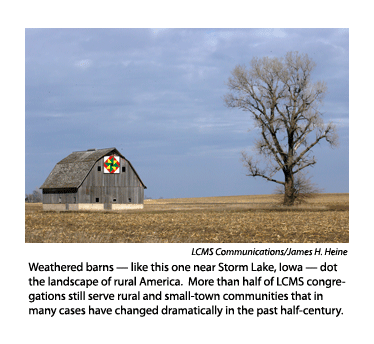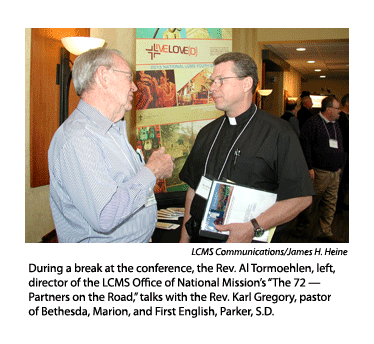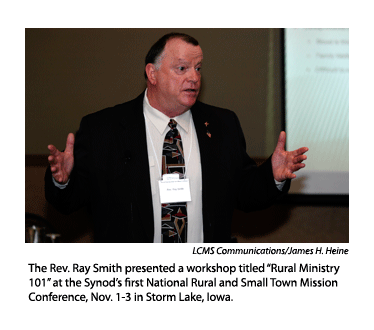By James H. Heine
STORM LAKE, Iowa — Perhaps it’s generational, but when many of us think of the heartland — of Iowa, for example — the image that comes to mind is one of rural tranquility: 4-H projects, county and state fairs, tidy farms with the  requisite white frame house and red barn, Grant Wood landscapes, Main Street visits on Saturday, church with family and friends on Sunday morning, Walther League softball Sunday afternoon.
requisite white frame house and red barn, Grant Wood landscapes, Main Street visits on Saturday, church with family and friends on Sunday morning, Walther League softball Sunday afternoon.
More than half the congregations of The Lutheran Church–Missouri Synod still serve rural and small-town settings, settings that in many cases have changed dramatically in the past half-century. This is true not only for Iowa, but also for rural communities throughout the country.
Increasingly, population has shifted to large metropolitan centers, following jobs and career opportunities. Family farms and ranches have morphed into agribusiness operations, requiring less manual labor while at the same time becoming more productive — and through consolidation — significantly larger. Conversely, as farms and their agribusiness counterparts have grown and (mostly) prospered, many small communities and congregations have slipped in the opposite direction.
Today, some of these congregations, like the communities they serve, struggle, not only with the cultural issues that confront our society as a whole, but also with issues of sustainability, viability and mission — and perhaps even with a sense of being overlooked by the Synod.
With this setting as a backdrop, the LCMS Office of National Mission (ONM) and its Rural and Small Town Mission team hosted the Synod’s first National Rural and Small Town Mission Conference here Nov. 1-3.
The goal was twofold:
- to provide hope and encouragement to pastors and lay leaders who at times may feel discouraged by the challenges that confront their congregations, and
- to offer ideas for meeting those challenges and a venue in which to share and discuss those ideas.
“We also want to make those in attendance aware of the great mission field that rural America offers today,” said the Rev. Dr. Lee Hagan, interim director of LCMS Rural and Small Town Mission (RSTM), in an email to Reporter before the start of the conference.
Response to the conference was “extraordinary,” Hagan said. By the time registration closed Sept. 15, the conference had reached its capacity of some 160 participants, with those participants coming from as far away as Maryland and California, Florida and Texas.
Rural Ministry 101
As organized by Hagan and the ONM, the conference offered a spectrum of plenary sessions and workshops, covering everything from demographics and rural culture to stewardship and resource development, networking, social media, bivocational clergy, outreach to immigrant populations, and the joys and challenges of serving multipoint parishes. Speakers included Hagan; LCMS Synod President Rev. Dr. Matthew C. Harrison; Carole White, Lutheran Church Extension Fund vice-president for the LCMS Iowa districts; the Rev. Ray Smith, pastor of First Lutheran Church, Missouri Valley, Iowa; the Rev. Dan Vogel, Iowa District West missionary to Hispanics; Dr. Mark Blanke, Concordia University, Nebraska; and Luther K. Snow, a nationally recognized speaker and writer who focuses on asset-based development and community and economic growth.
Also present at the conference were three LCMS district presidents: the Rev. Dr. Brian S. Saunders, Iowa East; the Rev. Dr. Paul G. Sieveking, Iowa West; and the Rev. Russell L. Sommerfeld, Nebraska.
Representatives from Lutheran Hour Ministries, Concordia Publishing House, the Lutheran Church Extension Fund, the LCMS Foundation and Concordia Plan S ervices attended the conference as well.
ervices attended the conference as well.
“With 81 percent of the congregations of Iowa District West, I believe it is critical that we look more closely at the congregations and the mission opportunities that continue to open up in our rural communities,” Sieveking observed. “Only half of the people of Iowa belong to a church. On any given Sunday, only 17 or 18 percent of the people in our communities are actually in worship.”
Sieveking noted also that the demographics of many rural and small-town congregations are changing. Storm Lake, for example, because of its meat-packing facilities, has the highest Hispanic/Latino population (36 percent) in Iowa.
“The Lord continues to send immigrants into our communities to work in our farms and factories. We need to see the mission fields that are all around us,” Sieveking said.
The Rev. Bart Day, ONM executive director, was scheduled to speak also but was unable to attend because of Superstorm Sandy relief efforts organized by the LCMS Disaster Response team, of which he was a part.
Standing in for Day, Hagan, in his opening remarks said, “The Synod and the ONM are here to support you.”
Blessings and challenges
In a presentation titled “Rural Ministry 101,” Smith, who is also Iowa District West’s executive assistant for Rural and Small Town Missions, highlighted aspects of rural life that can present both blessings and challenges. There are deep roots in family, land and community, he explained. There is a high re gard for independence and self-sufficiency, as well as a deep sense of pride in community (and congregation) and of place and heritage.
gard for independence and self-sufficiency, as well as a deep sense of pride in community (and congregation) and of place and heritage.
Yet, these same attitudes can inhibit change and limit vision, Smith noted. Deep-seated positions can lead to fractured and divided relationships. Commitments to family and community can limit a willingness to embrace newcomers. When adversity appears, independence and self-sufficiency can drift inward and refocus vision on survival and even a sense of unworthiness.
In such circumstances, many rural congregations can find it difficult to remain confident in Christ, Smith added, especially as members watch their community change, children and grandchildren move away, the pulpit become vacant, and church attendance and membership decline.
Yet, “even vacant ministries still have Christ at their center, and in Him, congregations can still be workers for the Kingdom,” Smith said. Consider the Parable of the Talents, he added. “Work in and with these congregations to use God’s gifts to turn outward for the kingdom of God, with confidence in His promises.”
Ministry to immigrants
In a presentation on outreach to Hispanic/Latino populations, Vogel, an Iowa District West missionary to Hispanics, noted that Spanish serves as the national language for 22 nations around the world. In Storm Lake and its surrounding communities, 10 of those nations are represented by Spanish-speaking people.
“Storm Lake is a microcosm of the nation,” Vogel said.
To reach out to Hispanic families, it’s important to remember that trust and respect are important issues, Vogel said. Many people — politicians, police, bankers, lawyers — are viewed as untrustworthy, he explained, so the defense mechanism is “if you want me to trust you, prove to me you’re trustworthy.”
It’s important also to remember the differences between Anglo and Latin cultures, as well as the limitations economic considerations sometimes impose on Latino families, Vogel said. In Hispanic culture, people and families come first, the clock and schedules later.
A definite asset in working with Latino communities is bilingual ability, Vogel added.
Church as community sparkplug?
In his plenary presentation to the conference, Harrison suggested that, while the circumstances many be different, rural congregations and urban congregations share many of the same challenges. Often, he said, the church, whether urban or rural, may be the only viable institution left in the community.
Recalling his experiences at Zion Lutheran Church in Fort Wayne, Ind., as well as the origin of what is now Lutheran Housing Support, Harrison posed this question: “Every small town has certain needs. What if the Lutheran Church becomes the sparkplug [for development] in your community?”
Harrison also encouraged visitation: Pastors should visit their members. “They should preach, visit and be visible,” he stated. “Jesus goes.” If a pastor does not “go,” his ministry “is toast,” Harrison said.
Regarding our life together, Harrison reminded participants that “we are bodied together in Christ. … We are in this together in Christ.”
This extends to our visitation of one another, Harrison observed. “How are the buildings in your circuit? … It’s time to help one another, to visit one another.”
In response to a question during the conference’s Q-and-A session, Harrison also encouraged the idea of endowments as a way to sustain ministry in small congregations, a topic that was addressed during a conference presentation by Terry Gerdts, LCMS Foundation senior vice-president, on resources “beyond the offering plate.”
“Look to your strengths,” Harrison said. “Small congregations have marvelous strengths.”
An encouraging beginning
Plans for next year’s conference are under way already, Hagan announced at the end of the conference. Suburban Kansas City is the likely site. Such a site will offer better interstate and airline access as well as more facility options, Hagan explained.
“We turned a lot of people away from this event,” he said.
Of the 2012 conference, Mike Zimmer, assistant to the president for the Minnesota South District in the area of mission formation, offered this assessment: “It’s been a very encouraging sign of unity that the speakers, the Bible study leader [Saunders], the workshop leaders all focused on celebrating the unity we have in our mission to intentionally engage people for Christ.”
About half of Minnesota South’s 245 congregations are located in rural areas, Zimmer said, and “there is a great awareness” of ministry opportunities. The district is seeking “to learn more about how we can help provide services, resources and tools that can help them reach their communities for Christ.”
Despite the challenges, the unity of hope in Christ is still present, Zimmer said. “That’s an encouraging thing — but also the importance of God’s grace coming through Word and Sacrament.”
For more information on Rural and Small Town Mission, the 2012 conference and available resources, visit www.lcms.org/rstm or call 888-463-5127.
Posted Nov. 21, 2012




